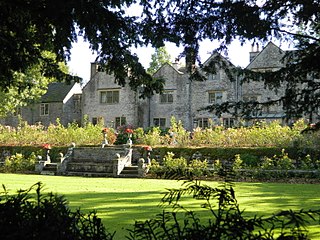
The Peak District is an upland area in England, at the southern end of the Pennines. Mostly in Derbyshire, it extends into Cheshire, Greater Manchester, Staffordshire, West Yorkshire and South Yorkshire and includes the Dark Peak, moorland dominated by gritstone, and the White Peak, a limestone area with valleys and gorges. The Dark Peak forms an arc on the north, east and west sides; the White Peak covers central and southern tracts. The Peak District was the first of the national parks of England and Wales in 1951. The historic Peak District extends beyond the National Park, which excludes major towns, quarries and industrial areas. Nearby Manchester, Stoke-on-Trent, Derby and Sheffield send millions of visitors. Inhabited from the Mesolithic era, it shows evidence of the Neolithic, Bronze and Iron Ages. Settled by the Romans and Anglo-Saxons, it remained largely agricultural; mining arose in the Middle Ages. Richard Arkwright built cotton mills in the Industrial Revolution. As mining declined, quarrying grew. Tourism came with the railways, spurred by the landscape, spa towns and Castleton's show caves.

Buxton is a spa town in the Borough of High Peak, Derbyshire, in the East Midlands region of England. It is England's highest market town, sited at some 1,000 feet (300 m) above sea level. It lies close to Cheshire to the west and Staffordshire to the south, on the edge of the Peak District National Park. In 1974, the municipal borough merged with other nearby boroughs, including Glossop, to form the local government district and borough of High Peak.

Hope is a village and civil parish in the Derbyshire Peak District, in England. The population at the 2011 Census was 864. It lies in the Hope Valley, at the point where Peakshole Water flows into the River Noe. To the north, Win Hill and Lose Hill stand either side of the Noe.

Ashbourne is a market town in the Derbyshire Dales district in Derbyshire, England. Its population was measured at 8,377 in the 2011 census and was estimated to have grown to 9,163 by 2019. It has many historical buildings and independent shops. The town offers a historic annual Shrovetide football match. Its position near the southern edge of the Peak District makes it the closest town to Dovedale, to which Ashbourne is sometimes referred to as the gateway.

Wirksworth is a market town in the Derbyshire Dales district of Derbyshire, England. Its population of 4,904 in the 2021 census was estimated at 5,220 in 2023. Wirksworth contains the source of the River Ecclesbourne. The town was granted a market charter by Edward I in 1306 and still holds a market on Tuesdays in the Memorial Gardens. The parish church of St Mary's is thought to date from 653. The town developed as a centre for lead mining and stone quarrying. Many lead mines were owned by the Gell family of nearby Hopton Hall.

Tissington is a village and former civil parish, now in the parish of Tissington and Lea Hall, in the Derbyshire Dales district of Derbyshire, England. In 2001 the parish had a population of 158. The population "Tissington and Lea Hall" at the 2011 census was 159. It is part of the estate of Tissington Hall, owned by the FitzHerbert family since 1465. It is a popular tourist attraction, particularly during its well dressing week. It also gives its name to the Tissington Trail, a 13-mile (21 km) walk and cycle path which passes nearby. The Limestone Way, another long-distance path and bridleway, passes through the village itself.

The Cromford and High Peak Railway (C&HPR) was a standard-gauge line between the Cromford Canal wharf at High Peak Junction and the Peak Forest Canal at Whaley Bridge. The railway, which was completed in 1831, was built to carry minerals and goods through the hilly rural terrain of the Peak District within Derbyshire, England. The route was marked by a number of roped worked inclines. Due to falling traffic, the entire railway was closed by 1967.

The history of Derbyshire can be traced back to human settlement since the last Ice Age, over 10,000 years ago. The county of Derbyshire in England dates back to the 11th century.
A barmote court is a court held in the lead mining districts of Derbyshire, England, for the purpose of determining the customs peculiar to the industry and also for the settlements of any disputes which may arise in connection with it.

This is a list of Sheriffs of Derbyshire from 1567 until 1974 and High Sheriffs since.
The Derbyshire County FA Senior Cup is a local county football cup for teams based in the county of Derbyshire. Founded in 1883–1884, the first competition was won by Staveley, who beat Derby Midland 2–1 in the final. 1885–1886 saw Heeley from Yorkshire win the competition. It was not until 1892 that the county's top club Derby County first won the trophy. This delay was partially helped by a disagreement during Derby County's first season 1884–1885. After beating Derby St. Luke's and Wirksworth, Derby County were drawn at home to Long Eaton Rangers in the third round. The club applied for a week's delay in playing the fixture, however Long Eaton Rangers claimed the tie stating that they weren't aware of any change in date and had arrived on the set date to play. A correspondent of the 'Derby Daily Telegraph' wrote that the referee had arrived to take charge on the re-arranged date. The Derbyshire County FA awarded the tie to Long Eaton Rangers and the following season Derby County played in the Birmingham and District FA Senior Cup and set up their own Charity Cup. Players also boycotted playing for the County FA team in protest. It wasn't until 1887–1888 that Derby County next played in their own county's competition, where again in the third round they were drawn to play Long Eaton Rangers who won the tie 4–1.

A soul cake, also known as a soulmass-cake, is a small round cake which is traditionally made for Halloween, All Saints' Day and All Souls' Day to commemorate the dead in many Christian traditions. The cakes, often simply referred to as souls, are given out to soulers who go from door to door during the days of Allhallowtide singing and saying prayers "for the souls of the givers and their friends", especially the souls of deceased relatives, thought to be in Purgatory. The practice in England dates to the medieval period, and was continued there until the 1930s. In Sheffield and Cheshire, the custom has continued into modern times. In Lancashire and in the North-east of England soul cakes were known as Harcakes, a kind of thin parkin.

"The Derby Ram" or "As I was Going to Derby" is a traditional tall tale English folk song that tells the story of a ram of gargantuan proportions and the difficulties involved in butchering, tanning, and otherwise processing its carcass.

Bradbourne Hall is a country house near All Saint's Church, within the civil parish of Bradbourne, near Ashbourne, Derbyshire. It is a privately owned Grade II* listed building, and is not open to the public.

All Saints’ Church, Bradbourne is a Grade I listed parish church in the Church of England in Bradbourne, Derbyshire.

Old Tup, sometimes termed the Derby Tup or the Derby Ram, is a folk custom found in an area of the East Midlands of England. Geographically, the custom was found on the borders of Derbyshire and Yorkshire and stretched into part of Nottinghamshire. The tradition entails the use of a hobby horse with a goat's head that is mounted on a pole and carried by an individual hidden under a sackcloth. It represents a regional variation of a "hooded animal" tradition that appears in various forms throughout the British Isles. In geographical location and style it displays strong similarities with the Old Horse custom, but in the latter the hobby horse was presented as a horse rather than a ram.

Lutudarum was a town in the Roman province of Britannia, in the area that is now mid-Derbyshire. The settlement is believed to have been at either Wirksworth or nearby Carsington, although Matlock and Cromford are other candidates. The town was recorded as Lutudaron between Derventio and Veratino (Rocester) in the Ravenna Cosmography's list of all known places in the world in about 700 AD.

Tissington and Lea Hall is a civil parish within the Derbyshire Dales district, which is in the county of Derbyshire, England. Named for its settlements and sparsely built up with much rural expanse, its population was 134 residents in the 2021 census. The parish is 125 miles (201 km) north west of London, 15 miles (24 km) north west of the county town of Derby, and 3 miles (4.8 km) north of the nearest market town of Ashbourne. It shares a boundary with the parishes of Ballidon, Bradbourne, Fenny Bentley, Kniveton, Newton Grange, Parwich and Thorpe. The parish is wholly within the Peak District National Park.
















